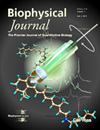Coarse-Grained Molecular Dynamics Simulation of Solvent-Dependent Cellulose Nanofiber Interactions
IF 3.1
3区 生物学
Q2 BIOPHYSICS
引用次数: 0
Abstract
Associations between cellulose are important both in biofuel production and in the use of cellulose for biomaterials. Cellulose nanofibers (CNFs) are sustainable, strong, light-weight alternatives to traditional materials in manufacturing, but are challenging to obtain due to irreversible aggregation in solution during preparative fibrillation. Therefore, it is imperative to understand the underlying factors driving aggregation with a view to designing solvents that can effectively compete with inter-fiber interactions, hence reducing aggregation. Molecular dynamics (MD) simulation at atomic detail can provide useful information on local interactions. However, the length and timescales accessible are too short to fully capture association processes. Here, we provide a method for accessing the longer length and timescales required using coarse-grained (CG) MD simulations with a MARTINI force field to calculate the interaction behavior of CNFs in three selected solvents: NaOH-urea-water, acetone, and neat water. The CG results are consistent with our prior all-atom MD and with previous experimental results. While acetone is found not to be an effective solvent, urea and ionic moieties in NaOH-urea-water not only solvate the fibrils but also improve the confinement of water molecules around them as shown by the solvent residence times and mean-square displacements. Overall, the presence of urea and ions reduces the likelihood of aggregation in multi-CNF systems relative to neat water irrespective of whether the hydrophobic or hydrophilic CNF surfaces are interacting. The CG method shows clear promise for selecting potential high-performance solvents for experimental prioritization in bioenergy and biomaterials research in a relatively fast manner as well as for understanding the aggregation and rheological behavior of CNF-solvent systems.溶剂依赖性纤维素纳米纤维相互作用的粗粒度分子动力学模拟
纤维素之间的联系在生物燃料生产和纤维素用于生物材料中都是重要的。纤维素纳米纤维(CNFs)在制造中是传统材料的可持续、强、轻的替代品,但由于在制备纤颤过程中溶液中的不可逆聚集,因此难以获得。因此,有必要了解驱动聚集的潜在因素,从而设计出能够有效地与纤维间相互作用竞争的溶剂,从而减少聚集。分子动力学(MD)在原子细节上的模拟可以提供有关局部相互作用的有用信息。但是,可访问的长度和时间尺度太短,无法完全捕获关联过程。在这里,我们提供了一种方法来获得所需的更长的长度和时间尺度,使用粗粒度(CG) MD模拟和MARTINI力场来计算CNFs在三种选定溶剂(naoh -尿素-水,丙酮和纯水)中的相互作用行为。CG结果与我们先前的全原子MD和先前的实验结果一致。虽然丙酮不是有效的溶剂,但naoh -尿素-水中的尿素和离子部分不仅溶解了原纤维,而且改善了原纤维周围水分子的约束,这可以从溶剂停留时间和均方位移中看出。总的来说,相对于纯水,尿素和离子的存在降低了多CNF系统中聚集的可能性,而不管疏水或亲水CNF表面是否相互作用。CG方法在生物能源和生物材料研究中以相对快速的方式选择潜在的高性能溶剂,以及了解cnf溶剂系统的聚集和流变行为方面显示出明确的前景。
本文章由计算机程序翻译,如有差异,请以英文原文为准。
求助全文
约1分钟内获得全文
求助全文
来源期刊

Biophysical journal
生物-生物物理
CiteScore
6.10
自引率
5.90%
发文量
3090
审稿时长
2 months
期刊介绍:
BJ publishes original articles, letters, and perspectives on important problems in modern biophysics. The papers should be written so as to be of interest to a broad community of biophysicists. BJ welcomes experimental studies that employ quantitative physical approaches for the study of biological systems, including or spanning scales from molecule to whole organism. Experimental studies of a purely descriptive or phenomenological nature, with no theoretical or mechanistic underpinning, are not appropriate for publication in BJ. Theoretical studies should offer new insights into the understanding ofexperimental results or suggest new experimentally testable hypotheses. Articles reporting significant methodological or technological advances, which have potential to open new areas of biophysical investigation, are also suitable for publication in BJ. Papers describing improvements in accuracy or speed of existing methods or extra detail within methods described previously are not suitable for BJ.
 求助内容:
求助内容: 应助结果提醒方式:
应助结果提醒方式:


